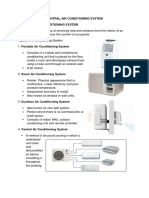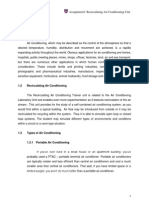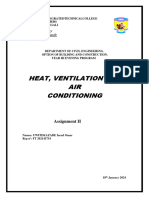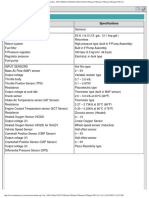Lab Experiment # 05: Objective
Lab Experiment # 05: Objective
Uploaded by
Sayam AliCopyright:
Available Formats
Lab Experiment # 05: Objective
Lab Experiment # 05: Objective
Uploaded by
Sayam AliOriginal Title
Copyright
Available Formats
Share this document
Did you find this document useful?
Is this content inappropriate?
Copyright:
Available Formats
Lab Experiment # 05: Objective
Lab Experiment # 05: Objective
Uploaded by
Sayam AliCopyright:
Available Formats
HVAC Lab Manual Wah Engineering College
Lab Experiment # 05
Objective:
To familiarize the students with split air conditioner and detail study of its various (indoor/outdoor)
components.
Introduction:
Air Conditioner:
It is basically a device used for the removal of heat from a confined space, cool the air below than
the ambient temperature which results the removal of humidity.
Types of Air Conditioners:
In HVAC there are different types of air conditioning systems for different applications. The most
commonly used are described below.
Window Air Conditioner
Split Air Conditioner
Central Air Conditioner
Window Air Conditioner:
The most common Air conditioner, which is used for small houses
and offices, is Window AC. It is a cubical unit, a complete conditioning system in itself; it requires a
window, or such space, where you can install it with its face inside the room. A window air
conditioner unit implements a complete air conditioner in a small space. The units are made small
enough to fit into a standard window frame. You close the window down on the unit, plug it in and
turn it on to get cool air. If you take the cover off of an unplugged window unit, you'll find that it
contains:
A compressor
An expansion valve
A hot coil (on the outside)
A chilled coil (on the inside)
Two fans
A control unit
The fans blow air over the coils to improve their ability to dissipate heat (to the outside air)
and cold (to the room being cooled).
Mechanical Engineering Department
HVAC Lab Manual Wah Engineering College
Split Air Conditioner:
It comprises of two parts: the outdoor unit and the indoor unit. The outdoor unit, fitted outside the
room, houses components like the compressor, condenser and expansion valve. The indoor unit
comprises the evaporator or cooling coil and the cooling fan. For this unit you don’t have to make
any slot in the wall of the room. Further, present day split units have aesthetic appeal and do not take
up as much space as a window unit. A split air conditioner can be used to cool one or two rooms.
In a split AC consists of 2 units… Indoor Unit and Outdoor Unit
Indoor unit consists of
Evaporator
Blower
Controller
Thermostat
Expansion device
Outdoor unit consist of
Compressor
Condenser coil
Condenser cooling fan
Central Air Conditioner:
If you want to cool more than two rooms or a larger space at your home or office, there are two
possible arrangements with the package unit. In the first one, all the components, namely the
compressor, condenser, expansion valve and evaporator are housed in a single box. Central air
conditions has a centralize duct system. The duct system has an air handler, air supply system, air
return duct and the grilles and register that circulates warm air from a furnace or cooled air from
central air conditioning units to our room. It returns that air back to the system and starts again. The
cooled air is thrown by the high capacity blower, and it flows through the ducts laid through various
rooms. In the second arrangement, the compressor and condenser are housed in one casing. The
compressed gas passes through individual units, comprised of the expansion valve and cooling coil,
located in various rooms.
Mechanical Engineering Department
HVAC Lab Manual Wah Engineering College
Components Of Split Ac:
Figure 1
Indoor Unit:
Evaporator:
An evaporator is a device used to turn the liquid form of a chemical into
its gaseous form. The liquid is evaporated, or vaporized, into a gas.
Cooling fan:
An inside fan pulls the air through the evaporator coils for cooling dispersal.
Thermostat:
The main role of an air conditioner thermostat is to regulate the temperature
within the air conditioned space, to the set temperature.
Control unit:
Air Conditioner Controllers have evolved to become more advance. Typical air
conditioner controller’s functions are compressor ON/OFF, Mode setting, timer, fan speed
and Air Louver.
Mechanical Engineering Department
HVAC Lab Manual Wah Engineering College
Outdoor Unit:
Compressor:
The compressor is a vapour compression pump which uses pistons or some
other method to compress the refrigerant gas and send it on its way to the condenser. The condenser
is a heat exchanger which removes heat from the hot compressed gas and allows it to condense into a
liquid.
Condenser:
Condenser Coils are outdoors and consists of a network of tubes filled with
refrigerant that remove heat from the heated gas refrigerant and convert the refrigerant into a
liquid form again. The excess heat escapes into the outside air.
Drainage system:
During the normal condensation process, an AC produces a significant
amount of water as a by-product. In a central AC system, there is a primary system of pipes,
often made of PVC, that carry this condensate water to the outside of the building.
Fan: An outside fan pulls the air through the condenser coils for heat dispersal.
Conclusion:
Yourself
Mechanical Engineering Department
You might also like
- Cop 215Document25 pagesCop 215Rico PangNo ratings yet
- Workshop Manual SL90 SeriesDocument110 pagesWorkshop Manual SL90 Seriesfreddy yagual89% (18)
- Lab Experiment # 06: Objective: Air ConditioningDocument5 pagesLab Experiment # 06: Objective: Air ConditioningSayam AliNo ratings yet
- Lab Experiment # 05: ObjectiveDocument4 pagesLab Experiment # 05: ObjectiveSayam AliNo ratings yet
- UNIT I - Air ConditionDocument62 pagesUNIT I - Air ConditionNeha JojanNo ratings yet
- Hvac 2Document3 pagesHvac 2emumerr69No ratings yet
- Group-07 - Schematic Details of Various AC Systems and The Concept of ZoningDocument37 pagesGroup-07 - Schematic Details of Various AC Systems and The Concept of ZoningVipin VetriNo ratings yet
- Architectural Building Services: Vedita Bhat Roll No-03Document8 pagesArchitectural Building Services: Vedita Bhat Roll No-03Vedita Bhat100% (1)
- AbstractDocument10 pagesAbstractabushasolomon75% (4)
- Types of HVAC SystemsDocument6 pagesTypes of HVAC Systemsm2110100% (1)
- Building Services - Iii: 3 Year BS - Semester 1Document32 pagesBuilding Services - Iii: 3 Year BS - Semester 1TaanayaNo ratings yet
- Unit 2 HVACDocument66 pagesUnit 2 HVACJaya SubhaNo ratings yet
- 141 Lecture 66Document14 pages141 Lecture 66kimNo ratings yet
- Air Condationing FinalDocument40 pagesAir Condationing FinalPeterson muchiriNo ratings yet
- Mapua Institute of Technolog1Document15 pagesMapua Institute of Technolog1Ian KasaiNo ratings yet
- Acu GlossaryDocument7 pagesAcu GlossaryErika RafaelNo ratings yet
- Types of Air Conditioning SystemDocument5 pagesTypes of Air Conditioning SystemLArry Vasquez100% (2)
- UCA - BST.F.2019.18 (Assingment 01)Document11 pagesUCA - BST.F.2019.18 (Assingment 01)shehan harshithaNo ratings yet
- Air Conditioning System Configurations - Electrical KnowhowDocument8 pagesAir Conditioning System Configurations - Electrical KnowhowJack WyhNo ratings yet
- 12 - Chapter 2 PDFDocument27 pages12 - Chapter 2 PDFMohd SalmanNo ratings yet
- Parts of Air ConditionerDocument6 pagesParts of Air ConditionerAntonio Lara MuñozNo ratings yet
- Air ConditioningDocument13 pagesAir ConditioningSumedha GuptaNo ratings yet
- HVAC System: Presented By: Zain Ul Abdeen Roll No: 2017-Uet-Gspct-Mech-29 Submitted To: Engr. Nasir Rafique DateDocument20 pagesHVAC System: Presented By: Zain Ul Abdeen Roll No: 2017-Uet-Gspct-Mech-29 Submitted To: Engr. Nasir Rafique DateshammiNo ratings yet
- Thermal Engineering 3 RD Year VTH Semester Notes Me8595Document4 pagesThermal Engineering 3 RD Year VTH Semester Notes Me8595vr3148438No ratings yet
- Air-Conditioning SystemDocument54 pagesAir-Conditioning Systemhasrul_nizam100% (6)
- Architectural Science (HVAC) Lecture 6 & 7Document32 pagesArchitectural Science (HVAC) Lecture 6 & 7ezakbelachewNo ratings yet
- Air CondationingDocument22 pagesAir CondationingPeterson muchiriNo ratings yet
- Air Conditioning SystemDocument4 pagesAir Conditioning Systemabenezer1425No ratings yet
- AC Plant Includes The CompressorDocument3 pagesAC Plant Includes The CompressorsidhumoosewalaNo ratings yet
- AIR COND SYSTEM EditedDocument37 pagesAIR COND SYSTEM Editedmohd irfanNo ratings yet
- R&AC Lab ManualDocument29 pagesR&AC Lab ManualPARAMESHNo ratings yet
- Types of Air ConditioningDocument9 pagesTypes of Air ConditioningENVERNo ratings yet
- ECM216 BUILDING SERVICES Bab 2.2 Air ConditioningDocument8 pagesECM216 BUILDING SERVICES Bab 2.2 Air ConditioningAZUAN BIN AHMAD FAUZI75% (4)
- Refrigeration and Air Conditioning 2Document33 pagesRefrigeration and Air Conditioning 2Christina Oh100% (1)
- Split Air Conditioner Learning SimulationDocument19 pagesSplit Air Conditioner Learning Simulationkablas100% (1)
- Design and Fabrication of Condenser For A Room Air Conditioning System (Rep1.)Document40 pagesDesign and Fabrication of Condenser For A Room Air Conditioning System (Rep1.)Satish Alan100% (1)
- District CoolingDocument17 pagesDistrict CoolingNexus Zubin KondoorNo ratings yet
- Centralised20ac20system 190120171416Document23 pagesCentralised20ac20system 190120171416Saba ArifNo ratings yet
- HVAC Chiller SystemDocument6 pagesHVAC Chiller SystemSiva SpurthyNo ratings yet
- Study On Air-Conditioning and Its ProcessDocument5 pagesStudy On Air-Conditioning and Its Processsdeep1990No ratings yet
- Air Conditioning-Window Air Conditioner: Building Services-VIDocument24 pagesAir Conditioning-Window Air Conditioner: Building Services-VINitin GrewalNo ratings yet
- Types of Air Conditioning: Qus 3206 / MDM Nurul AiniDocument56 pagesTypes of Air Conditioning: Qus 3206 / MDM Nurul AiniMalik MussaNo ratings yet
- Hvac NotesDocument129 pagesHvac Notesshahinkhan52535No ratings yet
- Air ConditioningDocument18 pagesAir ConditioningkuzenzamussaeliasNo ratings yet
- Air Conditioning SystemDocument7 pagesAir Conditioning SystemT SRNo ratings yet
- 8 - Lecture (8) Introduction To ACDocument24 pages8 - Lecture (8) Introduction To ACha3114No ratings yet
- M&E Assignment 3Document12 pagesM&E Assignment 3han0701No ratings yet
- Air Conditioning BasicsDocument2 pagesAir Conditioning BasicsLaurice Ortiz LuisNo ratings yet
- Central Air Conditioning SystemDocument5 pagesCentral Air Conditioning SystemRUSHALI SRIVASTAVA100% (1)
- Residential Building Design Using Prokon SoftwareDocument6 pagesResidential Building Design Using Prokon SoftwareJospin MwemaNo ratings yet
- Air Conditioning CycleDocument4 pagesAir Conditioning CycleJared ParaynoNo ratings yet
- Split SystemDocument16 pagesSplit Systemjhaamit4No ratings yet
- Principle of VRFDocument5 pagesPrinciple of VRFghazanfarhayat456No ratings yet
- Hvac EquipmentsDocument16 pagesHvac EquipmentsRahul Prajapati100% (1)
- Portable Air ConditonerDocument4 pagesPortable Air ConditonerAmit AgarwalNo ratings yet
- Air Conditioning SystemDocument12 pagesAir Conditioning SystemShahanajshanu100% (1)
- Air Conditioning SystemDocument7 pagesAir Conditioning SystemPapri MahataNo ratings yet
- Dasar Teori PendinginDocument64 pagesDasar Teori PendinginsuhandywNo ratings yet
- Basics of HVAC 4Document109 pagesBasics of HVAC 4wiraatmaja2905No ratings yet
- ME Lab ReportingDocument42 pagesME Lab ReportingJustino BalaneNo ratings yet
- Oral and Practical Review: Reflections on the Part 147 CourseFrom EverandOral and Practical Review: Reflections on the Part 147 CourseNo ratings yet
- Lab Experiment # 04: ObjectiveDocument3 pagesLab Experiment # 04: ObjectiveSayam AliNo ratings yet
- Lab Experiment # 03: ObjectiveDocument4 pagesLab Experiment # 03: ObjectiveSayam AliNo ratings yet
- Compressible Fluid Flow: Lecture Notes Fluid Mechanics - ME 326Document70 pagesCompressible Fluid Flow: Lecture Notes Fluid Mechanics - ME 326Sayam AliNo ratings yet
- Fluid Mechanics: Fundamentals and Applications, Yunus A. CengelDocument71 pagesFluid Mechanics: Fundamentals and Applications, Yunus A. CengelSayam AliNo ratings yet
- Turbomachinery: ME-326 Fluid Mechanics Wah Engineering CollegeDocument35 pagesTurbomachinery: ME-326 Fluid Mechanics Wah Engineering CollegeSayam AliNo ratings yet
- Power Plants (ME-327) : Assignment #2Document1 pagePower Plants (ME-327) : Assignment #2Sayam AliNo ratings yet
- Power Plants (ME-327) : Assignment #3Document2 pagesPower Plants (ME-327) : Assignment #3Sayam AliNo ratings yet
- Department of Mechanical Engineering Wah Engineering CollegeDocument3 pagesDepartment of Mechanical Engineering Wah Engineering CollegeSayam AliNo ratings yet
- Machine Design (ME - 316) : Assignment # 1 (PLO-2, CLO-2)Document3 pagesMachine Design (ME - 316) : Assignment # 1 (PLO-2, CLO-2)Sayam AliNo ratings yet
- 1 PDFDocument4 pages1 PDFSayam AliNo ratings yet
- 1 PDFDocument4 pages1 PDFSayam AliNo ratings yet
- Haskel Portable Hydrostatic Pressure Test SystemDocument2 pagesHaskel Portable Hydrostatic Pressure Test SystemindraNo ratings yet
- 1-2-1 EN Frese COMBIFLOW 6-WayDocument10 pages1-2-1 EN Frese COMBIFLOW 6-WayAliKarimliNo ratings yet
- Elektronik Spektrum Dari Molekul DiatomikDocument6 pagesElektronik Spektrum Dari Molekul DiatomikNiesy0% (1)
- 2.va1 Gedi 00HTF M M5 PHL 0001 - 1Document23 pages2.va1 Gedi 00HTF M M5 PHL 0001 - 1hoangduythanhqbNo ratings yet
- Hyundai Elantra 2005Document2 pagesHyundai Elantra 2005salah M.GNo ratings yet
- Thrills Workshop Home The Science of Roller Coasters Parent Support DocumentDocument9 pagesThrills Workshop Home The Science of Roller Coasters Parent Support DocumentChrisNo ratings yet
- Study of Manufacturing of Steam Turbine Blades: Project ReportDocument6 pagesStudy of Manufacturing of Steam Turbine Blades: Project ReportSumit royNo ratings yet
- VF PDFDocument42 pagesVF PDFBaihaki StNo ratings yet
- 2GIG CT100 User GuideDocument17 pages2GIG CT100 User GuideAlarm Grid Home Security and Alarm MonitoringNo ratings yet
- Section Subject: Shaybah CPF Expansion ProjectDocument21 pagesSection Subject: Shaybah CPF Expansion ProjectAdhie Waelacxh100% (1)
- Multi-Battery Isolator Application & Installation InstructionsDocument4 pagesMulti-Battery Isolator Application & Installation InstructionsCody McCormackNo ratings yet
- Case Studies For Traffic Solutions enDocument52 pagesCase Studies For Traffic Solutions enmaxventoNo ratings yet
- 13 - ElectrochemistryDocument2 pages13 - Electrochemistrysuppalerk janechaijitravanitNo ratings yet
- 03-01c Daily ChecksDocument21 pages03-01c Daily ChecksAnderson L RoncerosNo ratings yet
- Ausa Forklift c350h Parts ManualDocument10 pagesAusa Forklift c350h Parts Manualshirley100% (64)
- Datasheet MFHDocument3 pagesDatasheet MFHwan haffizNo ratings yet
- Duratrax ICE Backlight ModificationDocument10 pagesDuratrax ICE Backlight ModificationJose PetecaNo ratings yet
- Intake Pulse CalculationDocument14 pagesIntake Pulse CalculationShrikant Khating100% (6)
- Model: SWB-206-4: Backward Inclined Centrifugal Utility FanDocument21 pagesModel: SWB-206-4: Backward Inclined Centrifugal Utility FanSergio Garfias HNo ratings yet
- 0106-7 Section A-BDocument161 pages0106-7 Section A-BAliArababadiNo ratings yet
- TCE Ellen MacArthur Foundation 9 Dec 2015Document1 pageTCE Ellen MacArthur Foundation 9 Dec 2015Khurram AbbasiNo ratings yet
- Arc FlashDocument6 pagesArc FlashvenkyeeeNo ratings yet
- Environmental Good Practice in HotelsDocument54 pagesEnvironmental Good Practice in Hotelssheref_hamady100% (1)
- Chapter 9Document6 pagesChapter 9rickyNo ratings yet
- Aezy Joy T. Lascano Engr. May C. Layson Bsece-5ADocument5 pagesAezy Joy T. Lascano Engr. May C. Layson Bsece-5AAljon Ticsay LascanoNo ratings yet
- BIOLOGY 2 (4551/2) : Answering Questions Techniques SECTION A: STRUCTURED QUESTIONS (5 Compulsory Questions)Document6 pagesBIOLOGY 2 (4551/2) : Answering Questions Techniques SECTION A: STRUCTURED QUESTIONS (5 Compulsory Questions)Jedidah Jong100% (2)
- Indian Railways PL GroupDocument5 pagesIndian Railways PL GroupSibasish Sarkhel100% (2)
- Concealed Chilled Water Fan Coil Units DWX SeriesDocument22 pagesConcealed Chilled Water Fan Coil Units DWX SeriesShaik Bepari Jakeer100% (1)




































































































